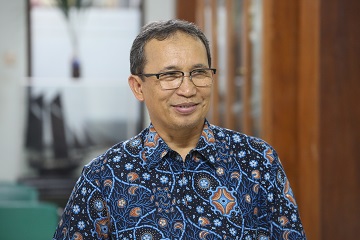High Lecturer of IPB Invents Seedless Oranges

Permanent High Lecturer of the Faculty of Agriculture Bogor Agricultural University (IPB), Prof. Dr. Ir. Agus Purwito explained a new method in plant breeding. According to him, nowadays plant nursery technologies are needed to quickly mass produce plant breeds, especially horticulture plants.
Conventional breeding means to obtain superior breeds through crossings. This crossing process has many limitations such as superior gene characteristics that are not always found in plants or that cannot be crossed due to the vast varieties. Other than that, the process to obtain these superior breeds takes up too much time. This was announced during the Pre Scientific Oral Press Conference which was held at IPB Campus Barangangsiang, Bogor (2/8).
“The obstacles that we face in agriculture are very heavy due to the rapid rate of increasing population, decrease of usable land, plant diseases (which is due to fact that we live in a tropical climate with high humidity which causes the rapid growth of microorganismes) which calls for the means of a new variety. Meanwhile there is also demand from the middle class for more high quality products. Therefore, we developed a few non-conventional methods to provide quality breeds and create new varities,” he said.
He said that these non-conventional methods can produce uniform plants (or similar to the parent), produces a higher quanitiy of breeds in a shorter amount of time and brreds with high productivity. “The use of invitro plant tissue isolation method is very important. For example, Indonesia has always imported the breeds for mini potatoes. In the year 1981, we started to produce mini tuber breeds from this plant tissue isolation method which nowadays is quite commonly found amongst the Indonesian community. These tissues are then cut and quarantined. This than results G0 mini tubers. This is then what we have given to the farmers. We are now also introducing somatic embrio methods which means one cells can become one kind of plant. This means that if we have millions of cells, we will have the potential to produce millions of plants. This can be turned into a bioreactor which means the amount of seedlings that we have will not become a problem.” He explained.
According to Prof. Dr. Ir. Agus, by using this invitro method the growth medium can become a selection agent. For example by adding the chemical PEG for resilience towards droughts (to find drought resistent seedlings), increasing the concentration of salt to select the salinity, or to increase the concentration of alumunium for the resilience towards the acidity of the soil, or to inoculate isolate bacteria to obtain plants which are resistent towards diseases so that they produce superior varieties.
For the means of creating new varities, the breeder can use these invitro mutagenesys methods. This method is one of the alternatives to obtain various varities and alternatives to turn on/off genes so that the desired gene can be expressed.
Superior varities are also produced through a combination of conventional and non-conventional methods. This method is the SSICD (Single Seed Invitro Clonal Descent). Two of the older potato plants are crossed, than the seedling which is produced is than sprouted using the invitro method. Each seed which has been sprouted using the invitro method and becomes one clone. Hundreds of clones are than selected using the invitro method to obtain a vigor clone, high productivity, and resistent towards biotic and abiotic threats.
“During the final stage, the selected clones are planted in soil so that the products can be confirmed. And this SSICD method has produced superior potato cultivars which are DEA potatos, katineng potatos, kagawa potatos, and gotik potatos (Garut authentic),” he explained.
Another method is by using protplast fusion. This method introduces the gene which originates form another plant which has distant gene relationship. Protoplast fusion can also be used to produce seedless plants. This is done by fusing protoplasts from the somatic plant tissues with the pollens protoplast so that it produces triploid plants which can produce seedless fruits. Seedless plants can be produced by endosperm culture.
“We have successfully obtained seedless oranges and the appearance of the colors seem to interest the consumers by fusing siam simadu oranges with mandarin satsuma oranges. 24 somatic hybrids have been produced which both have their own unique characteristics and are seedless. The product of these fused oranges have had their adaptivity levels tested in Malang, Bayuwangi, Cianjur, Garut, and Brastagi,” explains the High Lecturer who now has the position of Vice Rector of the Resources, Planning, and Finance Division of IPB. (AVR)



